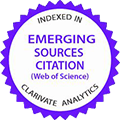Status of Green Banking in Islamic and Traditional Banks of Pakistan
DOI:
https://doi.org/10.28992/ijsam.v5i2.316Keywords:
green banking, Islamic banks, Pakistan, traditional banks.Abstract
The emergence of green banking has greatly increased the fierce competition between Islamic and traditional banks in Pakistan. Therefore, this study explores the current status of green banking in Islamic and traditional banks of Pakistan and the underlying reasons behind that status. A survey with semi-structured interviews was conducted between November 2019 and March 2020 among twenty banks. Overall, the findings reveal that the current level of green banking is low, but that Islamic banks still lead in green initiatives among banks in Pakistan. However, in certain sub-issues of green banking, there exist differences between the two groups of banks in terms of most and least implemented sub- issues. These differences arise from various factors, including the lack of awareness of the need for change, lack of knowledge and skills in green banking, lack of customer and institutional pressure for change, lack of incentives for change, lack of legal power to enforce change, banking culture in general, the culture of resistance to change, and the relative lack of malleability of the existing infrastructure. Further, this study is the first in the literature that describes the level of green banking for Islamic and traditional banks of Pakistan through the green banking index.

